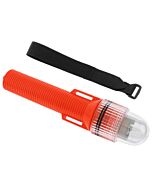TekTite Strobe 4500 XL Expedition
- DUAL 13-Watt LEDs makes an Extra-Bright Strobe (1300+ Lumens each)
- 50 hours on three C-cell batteries
- Twist on for activation
- Visible at the surface for several miles at night
- { 9.2 in | 23 cm } long - sturdy ALUMINUM body and LEXAN® lens material
TekTite Strobe 4500 XL Expedition
The Tektite 4500 XL strobe features a housing machined from a solid bar of aircraft aluminum plus a LEXAN® cap, solid-state circuitry and DUAL 13-Watt LEDs (1300+ Lumens each) lamp module; making this strobe the brightest and most shock resistant of Tektite strobes. The 4500 XL Strobe is double O-ring sealed, IP68M depth rated to { 2500 ft | 770 m }, twist on switch with non-slip grip, black color aluminum body with sturdy attachment point for snap or lanyard, runs 50 hours on a fresh set of three C-cell batteries and can also accept rechargeable Ni-Cad batteries. Visible at the surface for several miles/kilometers at night, the initial flash rate is 120 flashes per minute with fresh alkaline batteries. At { 9.2 in | 23 cm } long and { 2.2 in | 5.6 cm } wide this strobe is too big to fit in most pockets. Includes an adjustable wrist lanyard, and also includes a limited LIFETIME Warranty from TekTite.
| Brand | TekTite |
|---|---|
| SKU | TTI-3C-8000 |
| Weight | 2.000000 |
Customer Reviews
 WARNING
WARNING
Do not store any handheld flashlight or strobe for extended periods with alkaline batteries remaining inside the device, because unused alkaline chemistry batteries are prone to leaking. When alkaline chemistry batteries remain in unused devices for long periods, hydrogen gas can build up inside the cell casing until the pressure causes it to rupture, allowing the chemical components to leak out.










